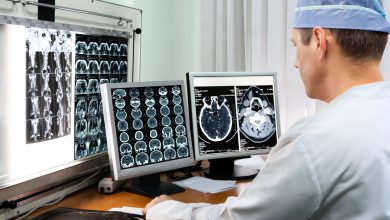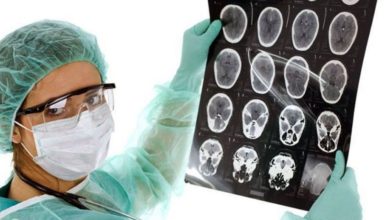Types of brain tumors
The content of the article
Types of brain tumors are classified depending on the type of cells, the degree of malignancy and the location of the tumor. Since tumors are very diverse, a unified classification has not been developed to date. This is due to the complexity of diagnosis and different opinions of specialists regarding specific neoplasias. meningioma is most often diagnosed . It is formed from the vessels of the soft meninges and accounts for 20% of neoplasms that develop within the skull.
Meningioma is a node that is located on the basal or convexital surface of the brain. If the disease is detected in a timely manner and the appropriate treatment method is applied, the prognosis for the development of the disease will be favorable. But if localization occurs in the brain stem, then the consequences will be unfavorable. This is because the small size of meningioma can put pressure on the nerve tissue and subsequently cause serious problems. Astrocytoma is one of the types of benign tumors. It is a growing tumor that is located in all parts of the brain. The disease is common among young people.
Types of brain tumors
Among malignant neoplasms, glioblastomas and medulloblastomas are distinguished. Glioblastoma is one of the most common types. Typically, it affects people between 40 and 60 years of age. The tumor does not have definite boundaries with tissues, so it can develop secondary changes. Among them are the formation of cysts , necrosis and hemorrhages. Metastases are found only in the brain, but the lesion develops quickly. This can lead to death of the patient within 3 months. Medulloblastoma is a malignant brain tumor because it is formed from immature medulloblast cells. The main reason for the formation of this pathology is dysgenetic processes. In other words, the embryonic rudiments are displaced during the prenatal period. At the same time, immature embryonic cells remain in the brain tissue. Therefore, medulloblastoma is often diagnosed in children. The lesion is mainly localized in the cerebellar vermis.
Along with the above, high-grade neoplasias are distinguished. They are characterized by low sensitivity to radiation, chemotherapy and even surgical removal. In this regard, the prognosis when this disease is detected is always poor.
What is the medical name for brain cancer?
This area of science characterizes this disease as a malignant formation that occurs in various membranes and formations of the brain. Among all registered tumors, this cancer accounts for about 1.5%.
To date, the exact causes of brain cancer have not been identified. However, some factors have been identified that can become a mechanism for triggering this oncology.
Among them are the following:
- Genetic diseases;
- Treatment using radiation therapy;
- The influence of viruses;
- Negative influence of mobile phones;
- Presence of tumors in other parts of the body;
- Harmful working conditions;
- Head injury;
- Smoking.
Symptoms
Many tumors develop asymptomatically, so they are detected only as a result of an autopsy. There are focal and cerebral signs of cancer development. They have similar symptoms, which can appear as a result of pressure from a malignant tumor on the brain.
Among the main symptoms of this cancer are the following:
- Permanent headache that gets worse when sneezing, bending or coughing;
- Dizziness;
- Vomiting and nausea;
- Constant weakness;
- Increased intracranial pressure;
- Visual and hearing impairment;
- Speech impairment;
- Indifference;
- Difficulty moving;
- Confusion;
- Hallucinations.
Symptoms such as nausea and vomiting are completely unrelated to food intake. They constantly accompany headaches. The vomiting reaction is not associated with food poisoning. Due to an acute headache, a person may become lethargic and drowsy. The patient is completely lost in space and does not understand where he is and who surrounds him. If the tumor is located in the motor cortex, paresis or complete immobility may develop. Paralysis occurs only on one half of the body.
If it is localized in the temples, then a person may experience auditory hallucinations. If the formation is located in the back of the head, then the hallucinations are visual in nature. The patient loses the ability to understand written text. There is a significant difference in the reaction of the pupils to light. Asymmetry of individual parts of the face and its parts is possible. The patient feels a lack of coordination, as there is staggering in a standing position and when walking. The person may become aggressive and lose control of their emotions. The pain sensitivity of certain parts of the body is completely or partially impaired. When formed in the pituitary gland, hormonal disorders occur.
Stages of tumor development
The following stages of disease development are distinguished.
- The neoplasm is located on the surface, so its components maintain their vital functions and do not spread. It is almost impossible to detect the disease at this stage.
- Progression of mutation. The neoplasm penetrates neighboring structures and affects the lymphatic vessels. Dizziness and headache appear. Visual disturbances and vomiting may occur. Metastases pass to the liver, lungs and cause their damage. Epileptic seizures may occur.
Diagnostics
A neurologist may order an examination if cancer is suspected. First, the doctor evaluates reflexes and vestibular functions. Only after this does he refer the patient to related specialists. They conduct electroencephalography, which allows you to determine the focus and degree of activity of the formation. The doctor will also make a diagnosis and identify the exact location. To do this, MRI , computed tomography and magnetic resonance angiography are performed. The latter method provides effective examination of the vessels that feed the tumor. To do this, a contrast agent is injected into the bloodstream. In order to draw up a treatment plan and prognosis for the future, a biopsy is used.
It is performed after constructing a three-dimensional model of the formation itself. Other methods are also used that make it possible to accurately determine the stage of development of the disease. To do this, instrumental diagnostics of the organs in which the tumor is located is carried out. The main treatment for brain cancer is surgery. Its implementation is possible only if there are boundaries between neoplasms. If the formation has spread to the meninges, then the operation cannot be performed. However, if it puts pressure on important areas of the brain, emergency surgery is performed. In this case, not all tumors are removed, but only parts. Removal occurs using a scalpel, laser or ultrasound. In order to reduce the number of infected cells, radiation therapy is performed. It is also prescribed for incomplete tumor removal or in the presence of metastases.
It is prescribed after 3 weeks from the date of surgery. Radiation therapy can be combined with chemotherapy.
Its task is to stop the activity of tumor cells. If it is impossible to remove using the above methods, then the person’s condition is improved with the help of radiotherapy. If a secondary appearance of the disease occurs, then remote irradiation of the head is performed. At the same time, the patient's hair falls out. But after a few weeks, they grow back. Targeted therapy uses drugs that block the growth of blood vessels. If the tumor is localized deep in important areas of the brain, then cryosurgery is prescribed.
Types of brain tumors in adults
Generally, the prevalence of cancer is described using different stages. However, brain tumors do not respond to this system because they spread throughout the brain and spinal cord. They practically do not spread to other parts of the body. To accurately determine treatment options, types of brain tumors in adults are classified by cell type.
This substance helps to control processes that are associated with the change of day and night. Piloid astrocytoma is an infected area that forms in astrocytes. They grow quite slowly and do not spread to other tissues. Pathologies of this type respond well to treatment. Diffuse astrocytoma tends to grow slowly, however, it can spread to other tissues.
Anaplatic astrocytoma is a malignant tumor that grows rapidly and affects nearby tissue. Gliboblastomas are malignant astrocytomas. They have a tendency to intensive growth and spread. Oligodendroglial occur in areas of the brain that nourish and support nerve cells. The names of all varieties come from the location and type of cells that make up the neoplasm.
There are the following types of brain tumors:
- Primary, which develop from nervous tissue;
- Secondary, which are metastases.
The first type is of particular importance, since it relates to diseases of the central nervous system. Neoplasms can be benign or malignant. Benign tumors do not differ from ordinary cells, so they do not penetrate other tissues. However, they can compress tissue and disrupt brain activity. Malignant tumors develop quickly and grow into nearby areas.
Benign brain tumors
- Meningioma. Among primary brain tumors, it is diagnosed in approximately 20%. This disease originates from the pia mater of the brain. Meningioma looks like a smooth and dense nodule that is connected to the pia mater. The size of this formation can range from a few millimeters to 16 centimeters. The prognosis for development will depend entirely on its location and size. After surgery, such formations do not recur.
- Schwannoma. Formed from the sheath of peripheral nerves. It consists of white nodes that are enclosed in a kind of capsule. May cause hearing loss and trigeminal neuralgia.
- Pituitary adenoma. Despite the fact that the formation grows quite slowly, it causes very severe symptoms.
- Astrocytoma. The tumor tends to grow slowly and can reach very large sizes. Often in its structure you can find various cysts. May develop into a malignant formation.
- Oligodendroglioma. It is a neoplasm of gray-pink color. Cystic formations develop inside. It occurs mainly in mature males.
- Ependymoma . Foci of necrosis and cystic formations may be located inside this neoplasm.
The classification of brain tissue neoplasia into malignant and benign is quite arbitrary. Because all types of brain cancer can cause serious damage, leading to the death of the patient.
The question of what brain cancer is called worries many people. This term refers to cancer, which is based on intensive cell division. In children, the disease occurs as a result of a disorder in the structure of genes that are responsible for the proper formation of the nervous system. Scientists have concluded that cells that are actively dividing are susceptible to change. Since such processes occur more often in children than in adults, tumors can occur even in newborns.
Please rate the article:





